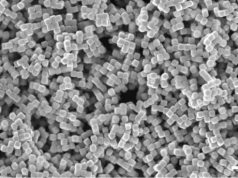Dental follicle stem cells cultured on different scaffolds for 10, 20 and 30 days. Alizarin red stain was used to detect stem cell mineralization (the red indicates the bone mineralization). Bone differentiation rate of cells on the cellulose-nanocrystal scaffold was faster compared to the bioplastics scaffold. Credit: Martin Chiang, National Institute of Standards and Technology.
What if you could take one of the most abundant natural materials on earth and harness its strength to lighten the heaviest of objects, to replace synthetic materials, or use it in scaffolding to grow bone, in a fast-growing area of science in oral health care?
This all might be possible with cellulose nanocrystals, the molecular matter of all plant life. As industrial filler material, they can be blended with plastics and other synthetics. They are as strong as steel, tough as glass, lightweight, and green.
“Plastics are currently reinforced with fillers made of steel, carbon, Kevlar, or glass. There is an increasing demand in manufacturing for sustainable materials that are lightweight and strong to replace these fillers,” said Douglas M. Fox, associate professor of chemistry at American University.
“Cellulose nanocrystals are an environmentally friendly filler. If there comes a time that they’re used widely in manufacturing, cellulose nanocrystals will lessen the weight of materials, which will reduce energy.”
Find your dream job in the space industry. Check our Space Job Board »
Fox has submitted a patent for his work with cellulose nanocrystals, which involves a simple, scalable method to improve their performance. Published results of his method can be found in the chemistry journal ACS Applied Materials and Interfaces. Fox’s method could be used as a biomaterial and for applications in transportation, infrastructure and wind turbines.
The power of cellulose
Cellulose gives stems, leaves and other organic material in the natural world their strength. That strength already has been harnessed for use in many commercial materials. At the nano-level, cellulose fibers can be broken down into tiny crystals, particles smaller than ten millionths of a meter. Deriving cellulose from natural sources such as wood, tunicate (ocean-dwelling sea cucumbers) and certain kinds of bacteria, researchers prepare crystals of different sizes and strengths.
For all of the industry potential, hurdles abound. As nanocellulose disperses within plastic, scientists must find the sweet spot: the right amount of nanoparticle-matrix interaction that yields the strongest, lightest property. Fox overcame four main barriers by altering the surface chemistry of nanocrystals with a simple process of ion exchange. Ion exchange reduces water absorption (cellulose composites lose their strength if they absorb water); increases the temperature at which the nanocrystals decompose (needed to blend with plastics); reduces clumping; and improves re-dispersal after the crystals dry.
Cell growth
Cellulose nanocrystals as a biomaterial is yet another commercial prospect. In dental regenerative medicine, restoring sufficient bone volume is needed to support a patient’s teeth or dental implants. Researchers at the National Institute of Standards and Technology, through an agreement with the National Institute of Dental and Craniofacial Research of the National Institutes of Health, are looking for an improved clinical approach that would regrow a patient’s bone. When researchers experimented with Fox’s modified nanocrystals, they were able to disperse the nanocrystals in scaffolds for dental regenerative medicine purposes.
“When we cultivated cells on the cellulose nanocrystal-based scaffolds, preliminary results showed remarkable potential of the scaffolds for both their mechanical properties and the biological response. This suggests that scaffolds with appropriate cellulose nanocrystal concentrations are a promising approach for bone regeneration,” said Martin Chiang, team leader for NIST’s Biomaterials for Oral Health Project.
Another collaboration Fox has is with Georgia Institute of Technology and Owens Corning, a company specializing in fiberglass insulation and composites, to research the benefits to replace glass-reinforced plastic used in airplanes, cars and wind turbines. He also is working with Vireo Advisors and NIST to characterize the health and safety of cellulose nanocrystals and nanofibers.
“As we continue to show these nanomaterials are safe, and make it easier to disperse them into a variety of materials, we get closer to utilizing nature’s chemically resistant, strong, and most abundant polymer in everyday products,” Fox said.
Source: American University
Journal Reference:
- Douglas M. Fox et al. Simultaneously Tailoring Surface Energies and Thermal Stabilities of Cellulose Nanocrystals Using Ion Exchange: Effects on Polymer Composite Properties for Transportation, Infrastructure, and Renewable Energy Applications, ACS Applied Materials & Interfaces (2016). DOI: 10.1021/acsami.6b06083











